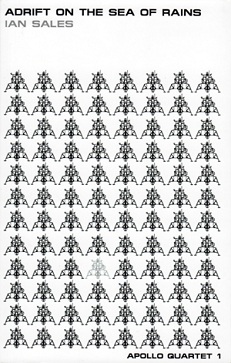
Adrift on the Sea of Rains
Ian Sales
75 pages
published in 2012
Ian Sales is a blogger and science fiction critic with strong options about what science fiction should and shouldn’t be and the conviction to put his opinions into practise. So for example, being dissatisfied with the lack of attention to women writers in science fiction and especially in the Gollancz science fiction Masterworks series, he launched the Sf Mistressworks blog to showcase overlooked classics by women writers. I don’t always agree with him, but he’s always interesting. Which is why I took a gamble on his fiction writing with Adrift on the Sea of Rains, a self published chapbook; normally something I wouldn’t bother with.
As he mentions in his biography page, Ian Sales was only three years old when Neil Armstrong set foot on the Moon, but it clearly left a deep impression nonetheless. It makes him about a decade older than myself, of the right age to be impressed by the seeming inevitability of nuclear war in the late seventies and early eighties, a Third World War that like the first seemed destined to be stumbled into rather than actively desired, all the more difficult to stop because of this. Somewhere in the mid-seventies we crossed the threshold where any nuclear war could still be survivable and reached the point where it just meant the end of the world. That was also the point at which the space race, the symbol of early Cold War machismo, ended, not in victory or defeat, but in a stalemate. The link between a better space programme and nuclear war is an old one in science fiction, as writers like Jerry Pournelle or Ben Bova, both in their fiction and outside it, arguing that space was vital for American national security, honest enough to understand that the space programme they wanted was only possible this way. Adrift on the Sea of Rains shows what could’ve happened had they been right, a story of nine astronauts in the US moonbase, left adrift after nuclear war destroyed the world.
Adrift on the Sea of Rains is told through the eyes of colonel Vance Peterson, USAF, who’s somewhat of a Right Stuff cliche, with “blonde wife and tow-headed son” back on Earth. How Peterson got on the Moon is told in a series of ever earlier flashbacks, which also hint at how the Cold War turned hot, while in the present he and his fellow astronauts are working on a way to escape the Moon by using the Bell, a piece of Nazi super science. It wouldn’t be enough just to get back to the dead and radioactive Earth they came from, instead they have to use the Bell to transport themselves into an alternate universe where the war didn’t happen. Which still of course leaves the problem of actually getting off the Moon…
Though Adrift on the Sea of Rains, especially the flashback sections, is written in the language of the technothriller, the mood it paints is that of seventies post-New Wave British science fiction, depressing and sombre. The combination works well though some of the more jargon heavy sections may be less accessible to those not that interested in obscure Cold War hypersonic fighter plane prototypes like the F-108 Rapier. To me though these casual mentions of these 1960ties wonder planes that in real life never went beyond the prototype stage strengthen the hubris that runs through the story. Planes like the Rapier, or the also mentioned Sukhoi T-4 and XB-70 are as much products of the sixties white heat of technology as the Apollo Project itself. In this timeline these sixties dreams of stronger, better, faster technology never ran out of steam but in the end turned out a nightmare.
This was the first story of Ian Sales I’ve read and it turned out to be as interesting as his non-fiction writing. I hope he’ll keep writing for a long time.